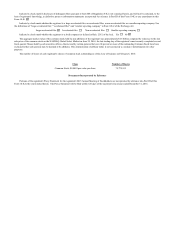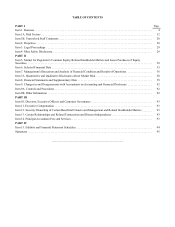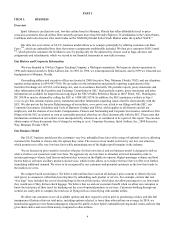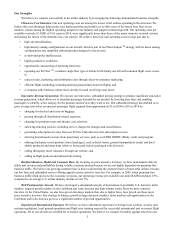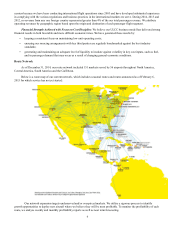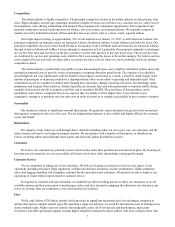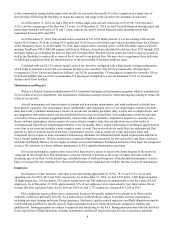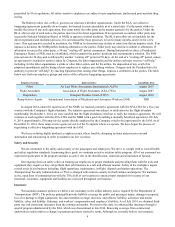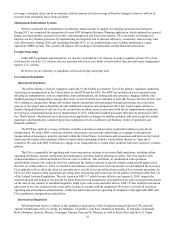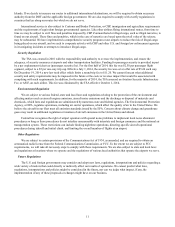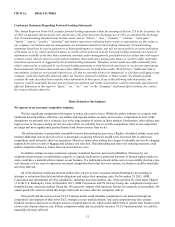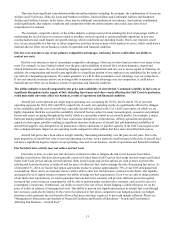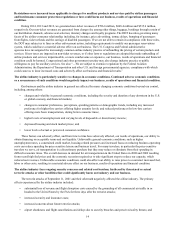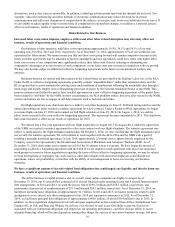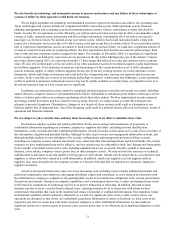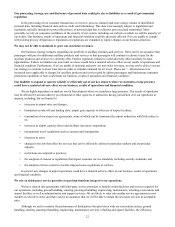Spirit Airlines 2014 Annual Report Download - page 12
Download and view the complete annual report
Please find page 12 of the 2014 Spirit Airlines annual report below. You can navigate through the pages in the report by either clicking on the pages listed below, or by using the keyword search tool below to find specific information within the annual report.12
ITEM 1A. RISK FACTORS
Cautionary Statement Regarding Forward-Looking Statements
This Annual Report on Form 10-K includes forward-looking statements within the meaning of Section 27A of the Securities Act
of 1933, as amended (the Securities Act), and Section 21E of the Securities Exchange Act of 1934, as amended (the Exchange
Act). Forward-looking statements may include words such as “believe,” “may,” “estimate,” “continue,” “anticipate,”
“intend,” “expect,” “predict,” “potential” and similar expressions indicating future results or expectations, as they relate to
our company, our business and our management, are intended to identify forward-looking statements. Forward-looking
statements should not be read as guarantees of future performance or results, and will not necessarily be accurate indications
of the times at, or by, which such performance or results will be achieved, if at all. Forward-looking statements are based on
information available at the time those statements are made and/or management's good faith belief as of that time with respect
to future events, and are subject to risks and uncertainties that could cause actual performance or results to differ materially
from those expressed in or suggested by the forward-looking statements. Therefore, actual results may differ materially from
what is expressed in or indicated by our forward-looking statements or from historical experience or our present expectations.
Known material risk factors that could cause these differences are set forth below under "Risk Factors." Additional risks or
uncertainties (i) that are not currently known to us, (ii) that we currently deem to be immaterial, or (iii) that could apply to any
company, could also materially adversely affect our business, financial condition, or future results. You should carefully
consider the risks described below and the other information in this report. If any of the following risks materialize, our
business could be materially harmed, and our financial condition and results of operations could be materially and adversely
affected. References in this report to “Spirit,” “we,” “us,” “our,” or the “Company” shall mean Spirit Airlines, Inc., unless
the context indicates otherwise.
Risks Related to Our Industry
We operate in an extremely competitive industry.
We face significant competition with respect to routes, fares and services. Within the airline industry, we compete with
traditional network airlines, other low-cost airlines and regional airlines on many of our routes. Competition in most of the
destinations we presently serve is intense, due to the large number of carriers in those markets. Furthermore, other airlines may
begin service or increase existing service on routes where we currently face no or little competition. Most of our competitors
are larger and have significantly greater financial and other resources than we do.
The airline industry is particularly susceptible to price discounting because once a flight is scheduled, airlines incur only
nominal additional costs to provide service to passengers occupying otherwise unsold seats. Increased fare or other price
competition could adversely affect our operations. Moreover, many other airlines have begun to unbundle services by charging
separately for services such as baggage and advance seat selection. This unbundling and other cost reducing measures could
enable competitor airlines to reduce fares on routes that we serve.
In addition, airlines increase or decrease capacity in markets based on perceived profitability. Decisions by our
competitors that increase overall industry capacity, or capacity dedicated to a particular domestic or foreign region, market or
route, could have a material adverse impact on our business. If a traditional network airline were to successfully develop a low-
cost structure or if we were to experience increased competition from other low-cost carriers, our business could be materially
adversely affected.
All of the domestic traditional network airlines have on one or more occasions initiated bankruptcy proceedings in
attempts to restructure their debt and other obligations and reduce their operating costs. On November 29, 2011, AMR
Corporation and substantially all of its subsidiaries, including American Airlines, Inc., filed a petition for relief under Chapter
11 of the U.S. Bankruptcy Code. In December 2013, AMR Corporation and US Airways Group, Inc. completed a merger and
formally became American Airlines Group Inc. We presently compete with American Airlines in a majority of our markets. We
cannot predict the extent to which this merger will result in a more effective competitor with us.
Our growth and the success of our ULCC business model could stimulate competition in our markets through our
competitors’ development of their own ULCC strategies or new market entrants. Any such competitor may have greater
financial resources and access to cheaper sources of capital than we do, which could enable them to operate their business with
a lower cost structure than we can. If these competitors adopt and successfully execute a ULCC business model, we could be
materially adversely affected.


